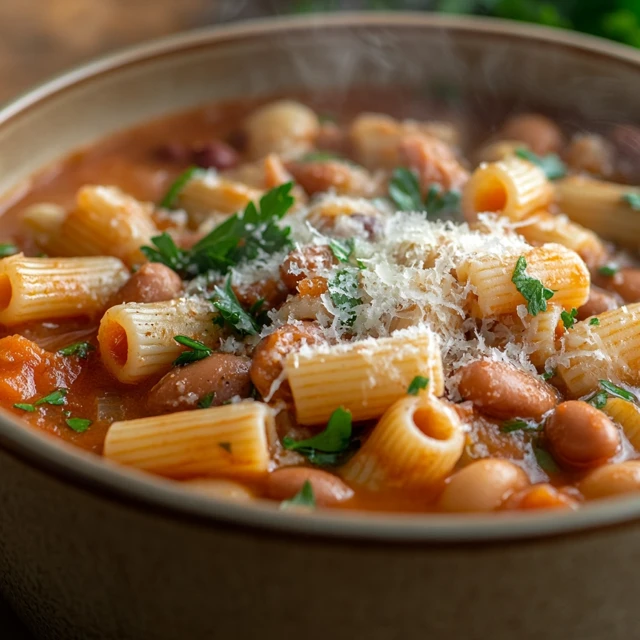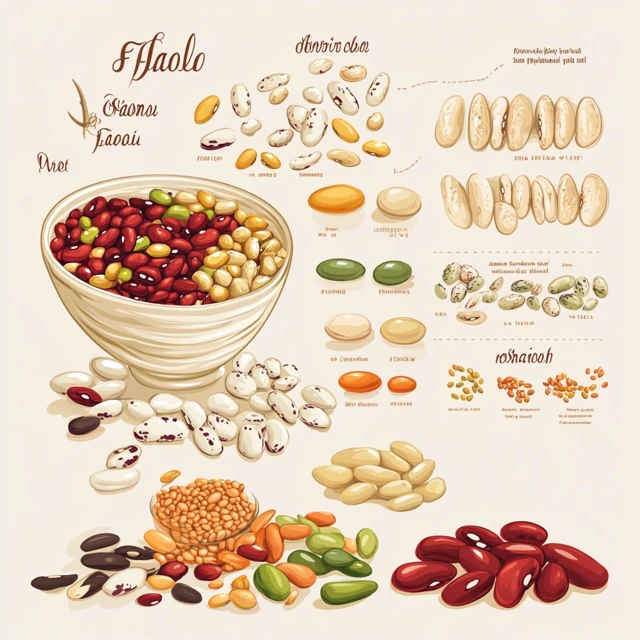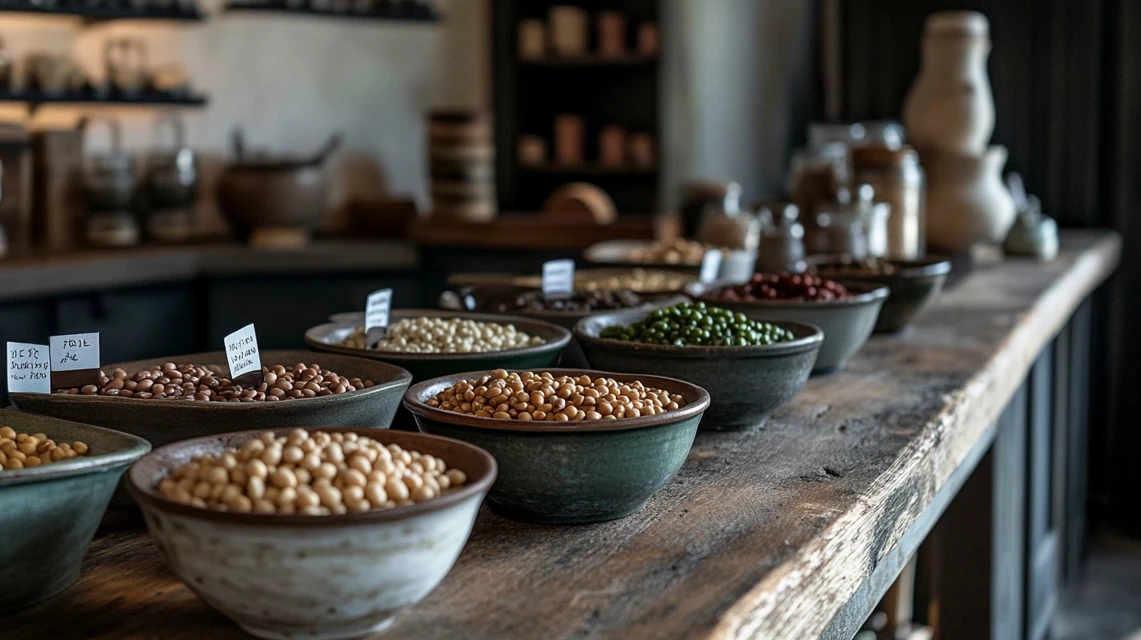In Italian cuisine, fagioli is a commonly used term that directly translates to “beans” in English. Beans are an essential part of Italian cooking and are featured in many traditional dishes across the country. Whether served in soups, stews, or side dishes, fagioli provide a nutritious and hearty component to meals.
The Meaning and Pronunciation of Fagioli
The word fagioli (pronounced fah-joh-lee) refers to beans in the plural form. It encompasses various types of beans used in Italian cuisine, such as cannellini, borlotti, and chickpeas. Beans have long been a staple in Italian diets, providing a rich source of protein and fiber.
Literal Translation of Fagioli in English
In English, fagioli translates simply to “beans.” However, the term is broad and can refer to several varieties of beans, each with its own unique characteristics and uses.
Some of the most popular beans classified under fagioli include:
- Cannellini Beans: White kidney beans that are creamy and mild in flavor, commonly used in soups like Pasta Fagioli and salads.
- Borlotti Beans: Also known as cranberry beans, they have a nutty taste and are often found in hearty stews.
- Chickpeas (Ceci): While not typically classified under fagioli, chickpeas are a popular legume in Italian cuisine, used in dishes like pasta e ceci.
- Lentils (Lenticchie): Another legume often mistaken for beans, frequently used in Italian soups and stews.
While these varieties share similarities, each type of fagioli has its distinct texture and flavor, making them suitable for different recipes.
check out this https://eassyrecipes.com/category/dinner/
How to Pronounce Fagioli Correctly
Many non-native speakers struggle with pronouncing fagioli correctly. The correct way to say it is fah-joh-lee, with the emphasis placed on the second syllable.
Different regions in Italy might have slight variations in pronunciation, but the standard Italian pronunciation is widely understood. If you’re dining at an Italian restaurant or cooking an authentic recipe, using the correct pronunciation can help you appreciate the cultural authenticity of the dish.
Singular vs. Plural Forms of Fagioli
In Italian, fagioli is the plural form, meaning multiple beans. The singular form of the word is fagiolo, which refers to a single bean.
For example:
- “Un fagiolo” – A single bean
- “Molti fagioli” – Many beans
While recipes and restaurant menus typically use the plural form, understanding the distinction can help when discussing ingredients in Italian markets or restaurants.
check out this https://eassyrecipes.com/category/dinner/
The Role of Fagioli in Italian Cuisine

Beans have played a crucial role in Italian cuisine for centuries, thanks to their affordability, versatility, and nutritional benefits. Italian cooks have mastered the art of incorporating fagioli into everyday meals, from hearty soups to satisfying side dishes.
Popular Types of Fagioli Used in Italian Cooking
Different types of beans are popular in various regions of Italy, with each type lending itself to specific dishes:
- Cannellini Beans:
- Used in Tuscan cuisine in dishes like Ribollita (a thick vegetable soup).
- Ideal for creamy dips and spreads.
- Borlotti Beans:
- Commonly used in Northern Italy in dishes like Pasta e Fagioli.
- Perfect for slow-cooked stews and hearty soups.
- Chickpeas (Ceci):
- Found in Southern Italy, often served in pasta dishes or salads.
- Frequently used in flour form to make farinata, a savory chickpea pancake.
check out this https://eassyrecipes.com/category/dinner/
Common Dishes That Feature Fagioli
Fagioli are an essential ingredient in many beloved Italian dishes, including:
- Pasta Fagioli: A classic bean and pasta soup, typically served with a tomato-based broth.
- Minestrone: A vegetable-rich soup featuring beans for added texture and nutrition.
- Fagioli all’Uccelletto: A Tuscan dish where cannellini beans are cooked with tomatoes, garlic, and sage.
- Zuppa di Fagioli: A rustic bean soup often enjoyed with crusty bread.
Whether served as a side dish, main course, or part of a soup, beans are a comforting and nutritious addition to Italian meals.
Nutritional Benefits of Fagioli
Beans are not only delicious but also packed with nutrients. They are an excellent source of plant-based protein, fiber, vitamins, and minerals, making them a healthy addition to any diet. Some key benefits include:
- High in Fiber: Promotes digestive health and helps regulate blood sugar levels.
- Rich in Protein: Provides a meat-free protein option for vegetarians and vegans.
- Low in Fat: Supports heart health by reducing cholesterol levels.
- Packed with Micronutrients: Beans contain essential nutrients such as iron, magnesium, and potassium.
Regional Variations of Fagioli in Italy

Italy is known for its diverse culinary traditions, and fagioli (beans) play a central role in many regional dishes. From the hearty bean soups of Tuscany to the lighter, herb-infused preparations of Southern Italy, beans have adapted to the unique flavors and cooking techniques of each region. Understanding these variations provides insight into how Italians incorporate fagioli into their daily meals.
Northern vs. Southern Italian Bean Dishes
Italian cuisine varies significantly from north to south, and bean-based dishes are no exception.
Northern Italy:
- Northern regions, such as Tuscany and Lombardy, tend to favor richer, more substantial dishes featuring beans.
- Beans are often cooked with meats like pancetta or sausage to create filling meals.
- Popular northern bean dishes include:
- Fagioli all’Uccelletto: A Tuscan dish with cannellini beans cooked in a tomato sauce with sage and garlic.
- Cassoeula: A hearty Lombard stew combining beans, pork, and cabbage.
- Ribollita: A thick, rustic Tuscan soup with beans, vegetables, and stale bread.
Southern Italy:
- In the southern regions, bean dishes tend to be lighter, focusing on fresh herbs and olive oil.
- Southern Italians often serve beans alongside seafood or incorporate them into pasta dishes.
- Common southern bean dishes include:
- Pasta e Ceci: A classic dish from Naples, combining chickpeas (ceci) with small pasta shapes in a light broth.
- Fagioli con Tonno: A refreshing salad featuring beans and tuna with a lemon and olive oil dressing.
- Minestra di Fagioli: A lighter bean soup with seasonal greens and a touch of chili flakes.
Each region’s approach reflects the local climate, available ingredients, and cultural influences that have shaped Italian cuisine for generations.
Traditional Cooking Methods Across Regions
From north to south in Italy, cooks prepare and cook their beans differently, following local traditions and using the tools they have. Let’s explore these cooking methods:
- Slow Cooking:
- First, in central and northern Italy, cooks gently simmer their beans with fresh herbs like rosemary and bay leaves.
- As a result, the beans soak up all these wonderful flavors and turn soft and creamy.
- Pressure Cooking:
- Meanwhile, in Southern Italy, many cooks now use this newer, faster way to cook beans while keeping their natural taste.
- Therefore, the beans stay firm and keep their healthy nutrients.
- Stewing:
- Additionally, many Italian cooks simmer their beans with tomatoes, garlic, and olive oil to make a rich stew.
- For instance, they create dishes like fagioli in umido, where the beans cook in a thick tomato sauce.
- Baking:
- Furthermore, in places like Tuscany, cooks put their beans in clay pots and bake them, which brings out deep, rich flavors.
- They often use this method when making hearty dishes like bean casseroles and layered pasta.
Above all, no matter how Italians cook their beans, these little powerhouses of nutrition remain at the heart of Italian cooking.
How Fagioli Are Used in Modern Italian Cuisine
While traditional bean dishes are still widely enjoyed, modern Italian chefs have embraced new ways of incorporating fagioli into contemporary recipes. Some creative ways beans are being used today include:
- In Salads: Light, protein-rich salads featuring beans mixed with fresh greens, tomatoes, and herbs.
- Bean-Based Spreads: Blended with olive oil and garlic to create creamy dips similar to hummus.
- As a Meat Substitute: Used in vegetarian versions of classic dishes such as bean-based meatballs or lasagna.
- Gluten-Free Options: Incorporating beans into gluten-free pasta dishes and baked goods for added protein and fiber.
With the growing interest in plant-based diets, fagioli continue to be a popular choice for their nutritional value and versatility.
Popular Italian Recipes Featuring Fagioli
There are countless delicious recipes that showcase beans as the star ingredient in Italian cuisine. Some of the most popular include:
- Zuppa di Fagioli (Bean Soup):
- A simple, nourishing soup made with white beans, tomatoes, and aromatic herbs.
- Often served with crusty bread and a drizzle of olive oil.
- Pasta e Fagioli (Pasta and Beans):
- A hearty one-pot dish combining pasta and beans in a tomato-based broth.
- Variations exist across Italy, with some preferring a thicker consistency and others a lighter, brothy version.
- Fagioli all’Uccelletto:
- Cannellini beans slowly cooked with garlic, tomatoes, and fresh sage for a comforting side dish.
- Insalata di Fagioli (Bean Salad):
- A refreshing bean salad dressed with olive oil, lemon juice, and fresh parsley.
These traditional recipes highlight the comforting flavors and satisfying textures that beans bring to Italian cuisine.
FAQs About Fagioli
Beans, or fagioli in Italian, have long been a staple in Italian cuisine. Despite their simplicity, many people have questions about their meaning, cultural significance, and their role in classic dishes like Pasta e Fagioli. Below, we answer some of the most common questions about fagioli.
What Is the Meaning of Fagioli?
In Italian, fagioli (pronounced fah-joh-lee) simply means “beans.” It is the plural form of fagiolo, which refers to a single bean. The term encompasses a variety of legumes used in Italian cooking, including:
- Cannellini Beans: A popular white bean often found in soups and stews.
- Borlotti Beans: Known for their creamy texture and nutty flavor, used in rustic dishes.
- Chickpeas (Ceci): Frequently used in salads and pasta dishes.
- Lentils (Lenticchie): Although technically not beans, they are often grouped under the same category in Italian cuisine.
Beans, or fagioli, play an essential role in the Mediterranean diet, providing a rich source of protein, fiber, and essential nutrients. They are a key ingredient in many beloved Italian dishes, offering both nourishment and flavor.
What Does Fazool Mean in Italian Slang?
The term fazool is an Italian-American slang adaptation of the word fagioli. It originated from the Southern Italian and Neapolitan dialects, where fagioli is pronounced more like fasule (fah-zool-eh). Over time, Italian immigrants in the United States, especially in cities like New York, adapted the pronunciation to fazool, which became popular in Italian-American households.
Pasta Fazool became a common term in the U.S., immortalized in pop culture, such as in Dean Martin’s song That’s Amore, where he sings, “When the stars make you drool just like pasta fazool, that’s amore.”
Although fazool is not standard Italian, it has become an endearing and nostalgic term among Italian-Americans, representing comfort food and cultural heritage.
Why Is It Called PastaFagioli?
First, let’s look at the dish Pasta Fagioli, which means “pasta and beans” – a name that comes straight from its two main ingredients: small pasta and filling beans. Indeed, this simple name tells the story of how the dish began, as poor families created this meal to feed themselves well without spending much money.
As you travel through Italy, you’ll find that each region makes Pasta Fagioli in its own special way, using whatever ingredients grow nearby to create local flavors. For example, some cooks add tomatoes to make a richer broth, while others prefer a clear broth with just a few simple spices.
In the past, families would make this dish using basic ingredients they kept in their kitchen, which meant they could cook a hot, filling meal even when money was tight. Now, as time has passed, Pasta Fagioli has grown from its simple beginnings as a poor family’s meal into a comfort food that people love all over the world.
What Does the ‘E’ Stand for in Pasta eFagioli?
In the dish name Pasta e Fagioli, the e (pronounced “ay”) means “and” in Italian. Therefore, the literal translation of Pasta e Fagioli is “pasta and beans.” The phrase highlights the simplicity of the dish—combining two essential ingredients to create a flavorful, hearty meal.
This small conjunction is an essential part of Italian grammar and is commonly seen in other dish names such as:
- Spaghetti e Polpette: Spaghetti and meatballs.
- Pane e Vino: Bread and wine.
- Formaggio e Prosciutto: Cheese and ham.
While the dish is often shortened to “Pasta Fagioli” in English-speaking countries, Italians emphasize the e to maintain the authenticity of the dish’s name.
Conclusion
Fagioli, meaning “beans” in Italian, are a crucial part of Italian culinary traditions, appearing in everything from soups to stews to hearty pasta dishes. Whether you call it Pasta Fagioli or Pasta Fazool, the dish remains a testament to the simplicity and richness of Italian cuisine.
The Americanized term fazool reflects the cultural journey of Italian immigrants and their efforts to preserve their culinary heritage while adapting to a new environment. Regardless of the name or pronunciation, this beloved dish continues to bring warmth and comfort to tables around the world.
Next time you enjoy a bowl of Pasta e Fagioli, you’ll appreciate not just its flavor, but the history and cultural significance behind every bite.

